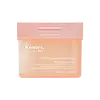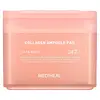What's inside
What's inside
 Key Ingredients
Key Ingredients

 Benefits
Benefits

 Concerns
Concerns

 Ingredients Side-by-side
Ingredients Side-by-side

Water
Skin ConditioningButylene Glycol
HumectantGlycerin
HumectantDipropylene Glycol
Humectant1,2-Hexanediol
Skin ConditioningSodium Citrate
BufferingHydroxyacetophenone
AntioxidantCitric Acid
BufferingGlycereth-25 PCA Isostearate
EmulsifyingZea Mays Kernel Extract
Ethylhexylglycerin
Skin ConditioningHydroxyethylcellulose
Emulsion StabilisingDisodium EDTA
Allantoin
Skin ConditioningAlaria Esculenta Extract
Skin ProtectingPanthenol
Skin ConditioningKaempferia Galanga Root Extract
Skin ConditioningFructan
Skin ConditioningCapryloyl Salicylic Acid
ExfoliatingGlucose
HumectantWater, Butylene Glycol, Glycerin, Dipropylene Glycol, 1,2-Hexanediol, Sodium Citrate, Hydroxyacetophenone, Citric Acid, Glycereth-25 PCA Isostearate, Zea Mays Kernel Extract, Ethylhexylglycerin, Hydroxyethylcellulose, Disodium EDTA, Allantoin, Alaria Esculenta Extract, Panthenol, Kaempferia Galanga Root Extract, Fructan, Capryloyl Salicylic Acid, Glucose
Water
Skin ConditioningGlycerin
HumectantGlycereth-26
Humectant1,2-Hexanediol
Skin ConditioningDiphenyl Dimethicone
EmollientTriethylhexanoin
MaskingBetaine
HumectantHydroxyacetophenone
AntioxidantHydrogenated Lecithin
EmulsifyingPolyglyceryl-10 Oleate
Skin ConditioningHydroxyethyl Urea
HumectantDipotassium Glycyrrhizate
HumectantSodium Citrate
BufferingAllantoin
Skin ConditioningOctyldodeceth-16
EmulsifyingXanthan Gum
EmulsifyingHydroxyethylcellulose
Emulsion StabilisingCollagen Extract
Skin ConditioningAdenosine
Skin ConditioningCitric Acid
BufferingDisodium EDTA
Olea Europaea Fruit Oil
MaskingButylene Glycol
HumectantPelargonium Graveolens Flower Oil
MaskingLavandula Angustifolia Oil
MaskingAnthemis Nobilis Flower Oil
MaskingCitrus Aurantium Dulcis Peel Oil
MaskingJuniperus Mexicana Oil
MaskingMangifera Indica Fruit Extract
Skin ConditioningLactobacillus Ferment
Skin ConditioningCeramide NP
Skin ConditioningMilk Protein Extract
Caprylyl Glycol
EmollientTripeptide-1
Skin ConditioningAcetyl Hexapeptide-8
HumectantCopper Tripeptide-1
Skin ConditioningPalmitoyl Tripeptide-1
Skin ConditioningPalmitoyl Pentapeptide-4
Skin ConditioningWater, Glycerin, Glycereth-26, 1,2-Hexanediol, Diphenyl Dimethicone, Triethylhexanoin, Betaine, Hydroxyacetophenone, Hydrogenated Lecithin, Polyglyceryl-10 Oleate, Hydroxyethyl Urea, Dipotassium Glycyrrhizate, Sodium Citrate, Allantoin, Octyldodeceth-16, Xanthan Gum, Hydroxyethylcellulose, Collagen Extract, Adenosine, Citric Acid, Disodium EDTA, Olea Europaea Fruit Oil, Butylene Glycol, Pelargonium Graveolens Flower Oil, Lavandula Angustifolia Oil, Anthemis Nobilis Flower Oil, Citrus Aurantium Dulcis Peel Oil, Juniperus Mexicana Oil, Mangifera Indica Fruit Extract, Lactobacillus Ferment, Ceramide NP, Milk Protein Extract, Caprylyl Glycol, Tripeptide-1, Acetyl Hexapeptide-8, Copper Tripeptide-1, Palmitoyl Tripeptide-1, Palmitoyl Pentapeptide-4
 Reviews
Reviews

Ingredients Explained
These ingredients are found in both products.
Ingredients higher up in an ingredient list are typically present in a larger amount.
1,2-Hexanediol is a synthetic liquid and another multi-functional powerhouse.
It is a:
- Humectant, drawing moisture into the skin
- Emollient, helping to soften skin
- Solvent, dispersing and stabilizing formulas
- Preservative booster, enhancing the antimicrobial activity of other preservatives
Allantoin is a soothing ingredient known for its protective and moisturizingg properties. Because of this, it is often added to products with strong active ingredients.
Studies show higher concentrations of this ingredient can promote wound healing.
Though it can be derived from the comfrey plant, allantoin is produced synthetically for cosmetic products to ensure purity.
Learn more about AllantoinButylene Glycol (or BG) is used within cosmetic products for a few different reasons:
Overall, Butylene Glycol is a safe and well-rounded ingredient that works well with other ingredients.
Though this ingredient works well with most skin types, some people with sensitive skin may experience a reaction such as allergic rashes, closed comedones, or itchiness.
Learn more about Butylene GlycolCitric Acid is an alpha hydroxy acid (AHA) naturally found in citrus fruits like oranges, lemons, and limes.
Like other AHAs, citric acid can exfoliate skin by breaking down the bonds that hold dead skin cells together. This helps reveal smoother and brighter skin underneath.
However, this exfoliating effect only happens at high concentrations (20%) which can be hard to find in cosmetic products.
Due to this, citric acid is usually included in small amounts as a pH adjuster. This helps keep products slightly more acidic and compatible with skin's natural pH.
In skincare formulas, citric acid can:
While it can provide some skin benefits, research shows lactic acid and glycolic acid are generally more effective and less irritating exfoliants.
Most citric acid used in skincare today is made by fermenting sugars (usually from molasses). This synthetic version is identical to the natural citrus form but easier to stabilize and use in formulations.
Read more about some other popular AHA's here:
Learn more about Citric AcidDisodium EDTA plays a role in making products more stable by aiding other preservatives.
It is a chelating agent, meaning it neutralizes metal ions that may be found in a product.
Disodium EDTA is a salt of edetic acid and is found to be safe in cosmetic ingredients.
Learn more about Disodium EDTAGlycerin is already naturally found in your skin. It helps moisturize and protect your skin.
A study from 2016 found glycerin to be more effective as a humectant than AHAs and hyaluronic acid.
As a humectant, it helps the skin stay hydrated by pulling moisture to your skin. The low molecular weight of glycerin allows it to pull moisture into the deeper layers of your skin.
Hydrated skin improves your skin barrier; Your skin barrier helps protect against irritants and bacteria.
Glycerin has also been found to have antimicrobial and antiviral properties. Due to these properties, glycerin is often used in wound and burn treatments.
In cosmetics, glycerin is usually derived from plants such as soybean or palm. However, it can also be sourced from animals, such as tallow or animal fat.
This ingredient is organic, colorless, odorless, and non-toxic.
Glycerin is the name for this ingredient in American English. British English uses Glycerol/Glycerine.
Learn more about GlycerinHydroxyacetophenone is antioxidant with skin conditioning and soothing properties. It also boosts the efficiency of preservatives.
This ingredient is not irritating or sensitizing.
Hydroxyethylcellulose is used to improve the texture of products. It is created from a chemical reaction involving ethylene oxide and alkali-cellulose. Cellulose is a sugar found in plant cell walls and help give plants structure.
This ingredient helps stabilize products by preventing ingredients from separating. It can also help thicken the texture of a product.
This ingredient can also be found in pill medicines to help our bodies digest other ingredients.
Learn more about HydroxyethylcelluloseSodium Citrate is the sodium salts of citric acid. In skincare, it is used to alter pH levels and acts as a preservative.
Its main functions are to maintain the pH of a product and neutralize metal ions.
The acidity of our skin is maintained by our glands and skin biome; normal pH level of skin is slightly acidic (~4.75-5.5).
Being slightly acidic allows our skin to create an "acid mantle". This acid mantle is a thin barrier that protects our skin from bacteria and contaminants.
Learn more about Sodium CitrateWater. It's the most common cosmetic ingredient of all. You'll usually see it at the top of ingredient lists, meaning that it makes up the largest part of the product.
So why is it so popular? Water most often acts as a solvent - this means that it helps dissolve other ingredients into the formulation.
You'll also recognize water as that liquid we all need to stay alive. If you see this, drink a glass of water. Stay hydrated!
Learn more about Water